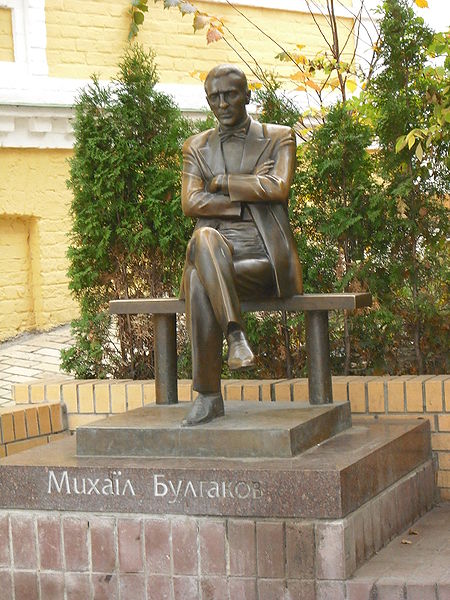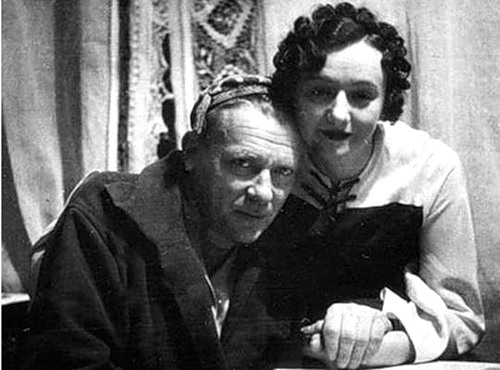<Back to Index>
- Astronomer Maximilian Hell, 1720
- Writer Mikhail Afanasyevich Bulgakov, 1891
- Indian Freedom Fighter Sukhdev Thapar, 1907
PAGE SPONSOR
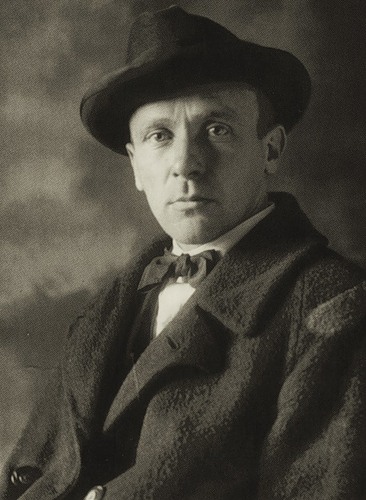
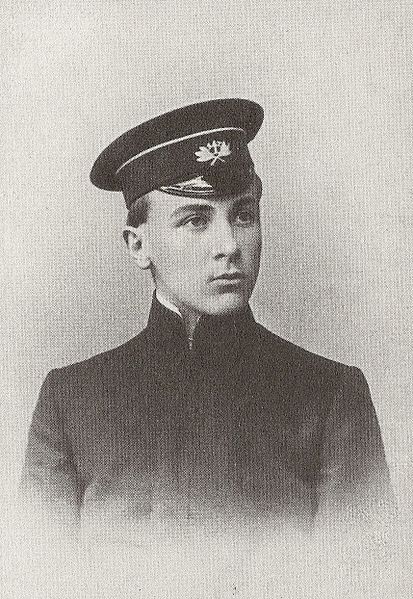
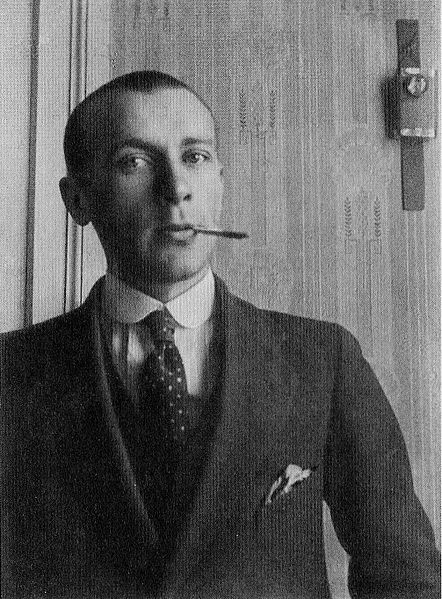
Mikhail Afanasyevich Bulgakov (Russian: Михаи́л Афана́сьевич Булга́ков, May 15 [O.S.May 3] 1891, Kiev – March 10, 1940, Moscow) was a Soviet Russian writer and playwright active in the first half of the 20th century. He is best known for his novel The Master and Margarita, which The Times of London has called one of the masterpieces of the 20th century.
Mikhail Bulgakov was born on May 15, 1891 in Kiev, at that time in the Russian Empire. He was the eldest son of Afanasiy Bulgakov, an assistant professor at the Kiev Theological Academy. Both of his grandfathers were clergymen in the Russian Orthodox Church. From 1901 to 1904 Bulgakov attended the First Kiev Gymnasium, where he developed an interest in Russian and European literature, theatre and opera.
In 1913 Bulgakov married Tatiana Lappa. At the outbreak of the First World War he volunteered with the Red Cross as a medical doctor and was sent directly to the frontline, where he was badly injured at least twice. In 1916, he graduated from the Medical Department of Kiev University and then served in the White Army alongside his brothers. He also briefly served in the Ukrainian People's Army.
After the Civil War and rise of the Soviets, much of his family emigrated to Paris (in exile). Mikhail and brothers ended up in the Caucasus. He first began to work as a journalist there, but when they were invited to return as doctors by the French and German governments, Bulgakov was refused permission to leave Russia because of typhus. This was when he last saw his family.
Bulgakov suffered from his long acting war wounds, which had a bad effect on his health. To suppress chronic pain, especially in the abdomen, he injected himself with morphine. Throughout the following years his addiction grew stronger. In one year (in 1918) he stopped injecting himself with morphine and never used it in the future. His book, entitled Morphine and released in 1926, provided an account of the writer's state during these years.
Though
his first fiction efforts were made in Kiev, he only decided to leave
medicine to pursue his love of literature in 1919. His first book was an almanac of feuilletons called Future Perspectives, written and published the same year. In 1921, Bulgakov moved to Moscow where he began his career as a writer. They settled near Patriarch's Ponds, close to Mayakovskaya metro station on the Sadovaya street, 10.
Four years later (in 1925), divorced from his first wife, he married
Lyubov' Belozerskaya. He published a number of works through the early
and mid 1920s, but by 1927 his career began to suffer from criticism
that he was too anti-Soviet. By 1929 his career was ruined, and
government censorship prevented publication of any of his work and staging of any of his plays. In
1932, Bulgakov married for the third time, to Yelena Shilovskaya, who
would prove to be the inspiration for the character of Margarita in his most
famous novel. During the last decade of his life, Bulgakov continued to
work on The Master and Margarita,
wrote plays, critical works, stories, and made several translations and
dramatisations of novels, librettos. Many of them were not published, other ones were "torn to pieces" by critics. Bulgakov wrote the play "Batum" glorifying Stalin's early revolutionary activity, but the play was banned by Stalin. However, Stalin had enjoyed another of Bulgakov's plays, The Days of the Turbins (1926) and found work for him at a small Moscow theatre, and then the Moscow Art Theatre.
Much of his work (ridiculing the Soviet system) stayed in his desk
drawer for several decades. In 1930 he wrote a letter to the Soviet
government, requesting permission to emigrate if the Soviet Union could
not find use for him as a writer.
In Bulgakov's autobiography, he claimed that he wrote to Stalin out of
desperation and mental anguish, never intending to post the letter. He
received a phone call directly from Joseph Stalin asking
the writer whether he really desired to leave the Soviet Union.
Bulgakov replied that a Russian writer cannot live outside of his
homeland. The
refusal of the authorities to let him work in the theatre and his
desire to see his family living abroad, whom he had not seen for many years, led him to seek drastic measures.
Despite his new work, the projects he worked on at the theatre were
often prohibited and he was stressed and unhappy. He also worked
briefly at the Bolshoi Theatre as a librettist but left when his works were not produced. Bulgakov died from nephrosclerosis (an inherited kidney disorder) on March 10, 1940. He was buried in the Novodevichy Cemetery in Moscow. His father had died of the same disease. During his life, Bulgakov was best known for the plays he contributed to Konstantin Stanislavsky's and Nemirovich - Danchenko's Moscow Art Theatre. Stalin was known to be fond of the play Days of the Turbins (Дни Турбиных) (1926), which was based on Bulgakov's novel The White Guard. His dramatization of Molière's life in The Cabal of Hypocrites (Кабала
святош) (1936) is still performed by the Moscow Art Theatre. Even after
his plays were banned from the theatres, Bulgakov wrote a comedy about Ivan the Terrible's visit into 1930s Moscow and the play "Batum" about the early years of Stalin (1939), which was prohibited by Stalin himself. Bulgakov began writing prose with The White Guard (Белая гвардия) (1924, partly published in 1925, first full edition 1927 – 1929, Paris) – a novel about the life of a White Army officer's family in civil war Kiev. In the mid 1920s, he came to admire the works of H. G. Wells and wrote several stories with elements of science fiction, notably The Fatal Eggs (Роковые яйца) (1924) and Heart of a Dog (Собачье
сердце) (1925). He intended to compile his stories of the mid twenties
(published mostly in medical journals) that were based on his work as a
country doctor in 1916 – 1918 into a collection titled Notes of a Young Doctor (Записки юного врача), but he died before he could publish it.
The Fatal Eggs
tells of the events of a Professor Persikov, who, in experimentation with
eggs, discovers a red ray that accelerates growth in living organisms. At the time, an illness passes through the chickens of
Moscow, killing most of them and, to remedy the situation, the Soviet
government puts the ray into use at a farm. Unfortunately there is a
mix up in egg shipments and the Professor ends up with chicken eggs, while the government run farm receives the shipment of ostrich, snake and crocodile eggs
that were meant to go to the Professor. The mistake is not discovered
until the eggs produce giant monstrosities that wreak havoc in the
suburbs of Moscow and kill most of the workers on the farm. The propaganda machine
then turns on Persikov, distorting his nature in the same way his
"innocent" tampering created the monsters. This tale of a bungling
government earned Bulgakov his label of a counter - revolutionary. Heart of a Dog features a professor who implants human testicles and pituitary gland into
a dog named Sharik (means "Little Balloon" or "Little Ball" - popular
Russian nickname for a male dog). The dog then proceeds to become more
and more human as time passes, resulting in all manner of chaos. The
tale can be read as a critical satire of the Soviet Union;
it contains few bold hints to communist leadership (e.g. the name of
the drunkard donor of the human organ implants is Chugunkin ("chugun"
is cast iron) which can be seen as parody on the name of Stalin
("stal'" is steel). It was turned into a comic opera called The Murder of Comrade Sharik by William Bergsma in 1973. In 1988 an award winning movie version Sobachye Serdtse was produced by Lenfilm, starring Yevgeniy Yevstigneyev, Roman Kartsev and Vladimir Tolokonnikov. The Master and Margarita (Мастер
и Маргарита), which Bulgakov began writing in 1928 and which was
finally published by his widow in 1966, twenty - six years after his
death, led to an international appreciation of his work. The book
contributed a number of sayings to the Russian language, for example,
"Manuscripts don't burn" and "second - grade freshness". A destroyed
manuscript of the Master is an important element of the plot, and, in
fact, Bulgakov had to rewrite the novel from memory after he burned the
draft manuscript of this novel. The
novel is a critique of Soviet society and its literary establishment.
The work is appreciated for its philosophical undertones and for its
high artistic level thanks to its picturesque descriptions (especially
of old Jerusalem), lyrical fragments and style. It is a frame narrative involving
two characteristically related time periods and/or plot lines: a
retelling of the gospels and a description of contemporary Moscow. The novel begins with Satan visiting Moscow in the 1930s, joining a conversation between a critic and a poet debating the existence of Jesus Christ and
the Devil. It then evolves into an all embracing indictment of the
corruption, greed, narrow mindedness, and widespread paranoia of Soviet
Russia. Published more than 25 years after Bulgakov's death, and more
than ten years after Stalin's, the novel firmly secured Bulgakov's
place among the pantheon of great Russian writers. There is a story - within - the - story dealing with the interrogation of Jesus Christ by Pontius Pilate and the Crucifixion. Bulgakov's old flat, and the attic of the apartment building, in which parts of The Master and Margarita are set, has since the 1980s become a gathering spot for Bulgakov's fans, as well as Moscow based Satanist groups, and had various kinds of graffiti scrawled
on the walls. The numerous paintings, quips, and drawings were
completely whitewashed in 2003. Previously the best drawings were kept
as the walls were repainted, so that several layers of different
colored paints could be seen around the best drawings. Although quite
old, the building stayed viable for a while. The building's residents,
in an attempt to deter loitering, are currently attempting to turn the
flat into a museum of Bulgakov's life and works. To date (February,
2005), they have had trouble contacting the flat's anonymous owner. On
December 21, 2006, the museum in Bulgakov's flat was damaged by an
anti-satanist protester and disgruntled neighbor, Alexander Morozov. The Bulgakov museum in Moscow remains
open and contains personal belongings, photos, and exhibitions related
to Bulgakov's life and his different works.
The Mikhail Bulgakov Museum (Bulgakov House) in Kiev, (in his family home, which was the model for the house of the Turbin family in The White Guard) has been converted to a literary museum with some rooms devoted to the writer, as well as some to his works. A minor planet 3469 Bulgakov discovered by Soviet astronomer Lyudmila Georgievna Karachkina in 1982 is named after him. The award winning British writer Salman Rushdie stated that The Master and Margarita was an inspiration for his own novel The Satanic Verses.
Mikhail Bulgakov is the most outstanding name related to Andrew’s Descent.
Before he was known as a writer he was a doctor specializing in
treatment of venereal diseases. He lived in house №13 and practiced
here. Among the items presented on the One Street Museum's display
are original photos of Mikhail Bulgakov, books and his personal
belongings. The museum also presents materials, related to the circle of
professors of Kiev Theological Academy, who used to live here at the
turn of 20th century and were friends and colleagues of Bulgakov's
father.
